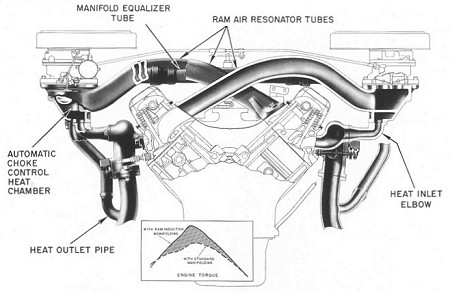 |
Chrysler's Ram Induction System
|
Ram induction provides torque increase of as much as ten percent in the 1800 to 3600 RPM range as compared with engines equipped with a single four-barrel carburetor. The increased torque is felt as a powerful push at normal passing speeds. It provides adequate power for quick, safe passing without the need to kick down the transmission into a lower range. The important thing is that ram induction puts the punch not at the "top end", where it would be useful only at very high engine speeds, but in the mid-speed range at which most drivers normally operate their engines. Still another advantage of ram induction is that when it is not needed, good fuel economy may be obtained under ordinary part-throttle driving conditions. How Ram Induction Works This is how ram induction obtains its "free" supercharging: 30-inch-long ram tubes carry a mixture of air and fuel at a high rate of speed directly to each combustion chamber. As the intake valve on the combustion chamber closes, the inertia of the fuel-air mixture set up in the long tubes ram an extra amount of the mixture into the chamber. At the same time, a sound wave is created in the tube, with the compression wave calculated to be at the intake valve just before it closes. The compression wave sends still another extra amount of fuel-air mixture into the chamber. These two "bonus" supplies of extra fuel-air mixture forced into the combustion chamber, account for the ram or extra power effect. Click here for more information.
Any comments or suggestions can be sent to .
|

